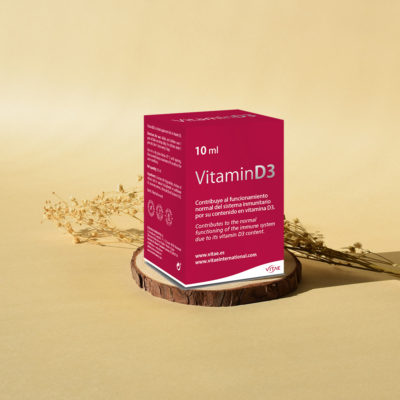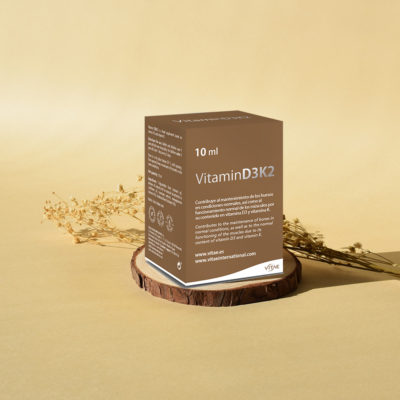Much has been said about vitamin D and its many health benefits. Currently there is a contradiction in society because we are constantly warned of sun damage but at the same time we are well aware of the importance of good vitamin D level. So the question is, if I protect myself from the sun I will not absorb it but, if I do not protect myself I will get the negative part of the sun. What shall we do?
Dr. Helena Rutllant explains in depth what vitamin D is, why it is so necessary for our body and how we can maintain adequate levels of this vitamin in the body.
- What is vitamin D and what are its health benefits?
Vitamin D is not only a nutrient, we say that it is a fat-soluble vitamin, but it is considered a true hormone with many different functions. One of its main functions is to maintain acceptable levels of calcium in blood to play a fundamental role in bone mineralization process. Another function is in its role on neuromuscular activity, signal transduction, defense against infections, etc.
The synthesis and metabolization process of this vitamin has been known since the beginning of the 20th century. The process begins in the transformation of 7-dihydrocholesterol to provitamin D and then to vitamin D, which requires 2 hydroxylations (the first in the liver and the second in the kidney, although it can also be performed to a lesser extent in other tissues such as the breast, prostate or colon, to be biologically active.
Vitamin D insufficiency is a global problem. If we look at the population over 65 years of age, we can find a percentage close to 100% (between 80-100%) with concentrations of 25-OH-colecalcifeol less than 20 ng / dl and if the population group is under 65 years of age, the percentage is between 40 and 50%.
This vitamin D deficiency may have extrinsic causes: low dietary intake (inadequate intake), low exposure to sunlight, use of sunscreens with ultraviolet radiation filters (SPF> 8) and cutaneous hyperpigmentation (it has been seen that the population with darker skin casually synthesizes less vitamin D).
Vitamin D has many functions, the most important ones perhaps being in the metabolism of calcium and phosphorus, bone health and also in the immune system.
Just thinking at the skeleton, its deficit in childhood can cause rickets and osteoporosis in adulthood. Active vitamin D will increase the absorption of calcium and phosphorus in the intestine, inhibit bone resorption and reduce the production of parathyroid hormone (PTH). These would be the typical functions of this vitamin, but there are also non-typical functions that participate in acute and chronic diseases, such as, for example, type 2 diabetes, some types of cancers, cardiovascular diseases, and infectious diseases (modulating cell growth, apoptosis or programmed cell death, angiogenesis, differentiation and regulation of the immune system, etc.).
We could say that a vitamin D deficiency is correlated with an increase in the incidence of cardiac, neurological and metabolic diseases, among others.
- Which people are more likely to have a vitamin D deficiency?
There is a term called hypovitaminosis, which means that there is a deficiency of a specific vitamin. We can think of this situation (greater probability of insufficiency of this vitamin) in the case of:
- Breast-feeding women.
- Elderly people, due to a double mechanism, as they have lower capacity to produce vitamin D and at the same time there’s lower renal conversion to its active form.
- People suffering from osteoporosis.
- Dark-skin people as they have a lower ability to produce vitamin D from the sun.
- People with kidney, liver, celiac disease, Crohn’s disease, sarcoidosis, TBC, lymphomas, etc.
- People treated with cholestyramine-type drugs (hypocholesterolemic), anticonvulsants, antifungals, retrovirals, glucocorticoids, etc.
- Obese people because in the adipose tissue part of this vitamin is retained, as it is fat soluble, and does not let it remain in the blood.
- In children it can cause rickets, they will have soft bones that will arch easily.
- In adults it will produce osteomalacy, and what we will observe will be people with bone pain, muscle pain and bone fragility.
A prolonged period in this situation can lead to a loss of bone density (osteopenia) which, if not corrected, can lead to osteoporosis and fracture. The body needs vitamin D to absorb calcium and without a sufficient amount of this vitamin we cannot produce calcitriol (the active form of vitamin D) and therefore even if we have a diet rich in calcium we will not be able to absorb it correctly via the intestines.
In this situation, the body will react by mobilizing the calcium reserves of the bone and teeth, which will eventually weaken both tissues.
- How can we increase vitamin D levels? Do you think that through food is enough?
We can obtain vitamin D in three ways:
- Exposing our skin to sunlight
- Diet (represents around 10-15% of daily requirements)
- Supplementation
The ideal is to do outdoor activities, in autumn and winter we will bring more clothes on so we will not get too much vitamin D. Here we must complement with food and / or supplements.
In spring and summer we should sunbathe at least 3 times a week for 15-20 min on the face and extremities, both upper and lower. This should be enough for us.
Despite the benefits of the sun in the synthesis of vitamin D, UVB rays can cause skin cancer. This is where we have to emphasize the precautions that we should take. Avoid exposures between 12 and 5 pm and do not use a sun protection factor less than 30. UV radiation increases 4% for every 300m of altitude and above all, the presence of clouds reduces the sensation of heat, but ultraviolet radiation continues acting.
An important point to take into account is also the amount of reflected ultraviolet radiation according to the different types of soil:
- Grass (0.5-5%)
- Water (10-20%) also lets 90% of UV rays pass.
- Sand (15-25%)
- Snow (50-90%)
Foods rich in vitamin D
- Fish: salmon, tuna, mackerel, sardines, oysters, shrimp, etc. The smaller the size of the fish the better, the larger the higher concentration of heavy metals, mercury, cadmium, dioxins, because they all accumulate mainly in the fatty tissue of animals.
- Dairy: whole milk, whole yogurts, cheeses (Edamm, Emmental, Parmesan, Manchego, etc.) and butter. Considering vitamin D is fat-soluble, skimmed foods won’t contain vitamin D.
- Eggs: yolk is the part of the egg where we find vitamin D.
- Veal liver, chicken, etc.
- Wheat germ and mushrooms (shiitake, mushrooms …).
The human body is able to use vitamin D2 (ergocalciferol) and vitamin D3 (cholecalciferol). Vitamin D2 is found in foods of plant origin, while vitamin D3 appears in foods of animal origin.
As we have previously mentioned, we could take into account the daily needs of each age group considering that through diet we will only obtain between 10-15% of the recommended daily intake.
Finally, mention that before supplement ourselves on our own, we should talk to a healthcare professional for advice and advise on the best treatment.








